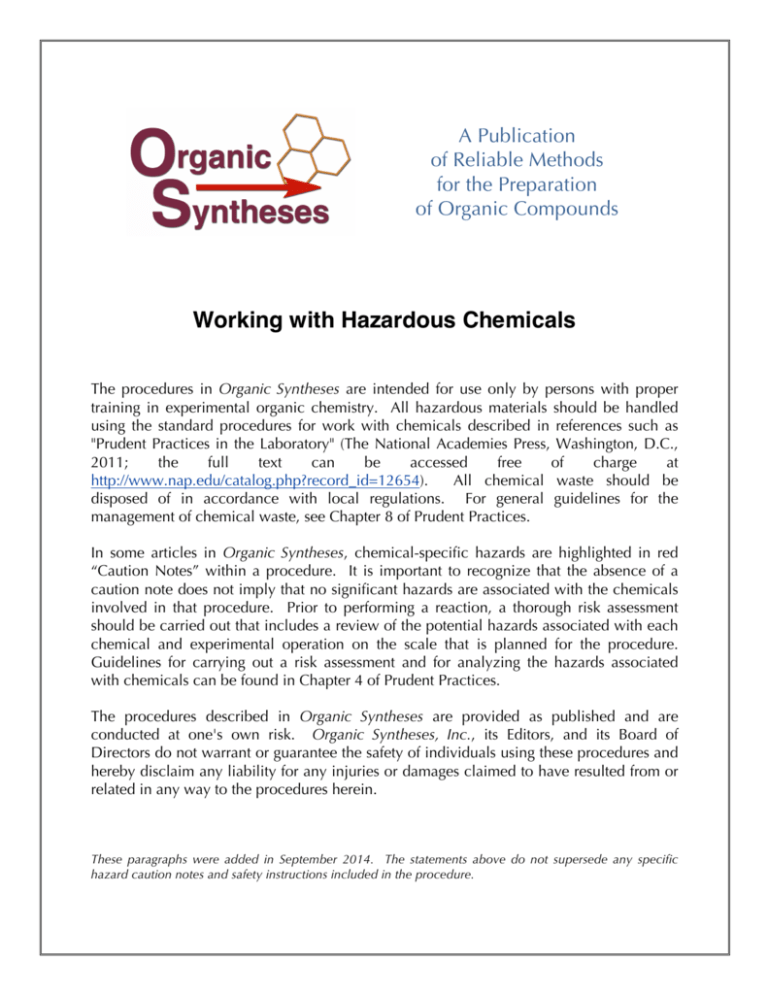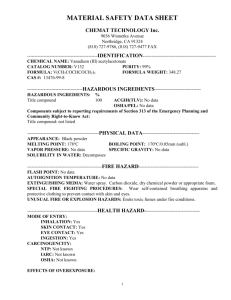
A Publication
of Reliable Methods
for the Preparation
of Organic Compounds
Working with Hazardous Chemicals
The procedures in Organic Syntheses are intended for use only by persons with proper
training in experimental organic chemistry. All hazardous materials should be handled
using the standard procedures for work with chemicals described in references such as
"Prudent Practices in the Laboratory" (The National Academies Press, Washington, D.C.,
2011;
the
full
text
can
be
accessed
free
of
charge
at
http://www.nap.edu/catalog.php?record_id=12654).
All chemical waste should be
disposed of in accordance with local regulations. For general guidelines for the
management of chemical waste, see Chapter 8 of Prudent Practices.
In some articles in Organic Syntheses, chemical-specific hazards are highlighted in red
“Caution Notes” within a procedure. It is important to recognize that the absence of a
caution note does not imply that no significant hazards are associated with the chemicals
involved in that procedure. Prior to performing a reaction, a thorough risk assessment
should be carried out that includes a review of the potential hazards associated with each
chemical and experimental operation on the scale that is planned for the procedure.
Guidelines for carrying out a risk assessment and for analyzing the hazards associated
with chemicals can be found in Chapter 4 of Prudent Practices.
The procedures described in Organic Syntheses are provided as published and are
conducted at one's own risk. Organic Syntheses, Inc., its Editors, and its Board of
Directors do not warrant or guarantee the safety of individuals using these procedures and
hereby disclaim any liability for any injuries or damages claimed to have resulted from or
related in any way to the procedures herein.
These paragraphs were added in September 2014. The statements above do not supersede any specific
hazard caution notes and safety instructions included in the procedure.
DOI:10.15227/orgsyn.051.0090
Organic Syntheses, Coll. Vol. 6, p.245 (1988); Vol. 51, p.90 (1971).
β-DIKETONES FROM METHYL ALKYL KETONES: 3-n-BUTYL2,4-PENTANEDIONE
Submitted by Chung-Ling Mao1 and Charles R. Hauser12.
Checked by David G. Melillo and Herbert O. House.
1. Procedure
A mixture of 28.6 g. (0.251 mole) of 2-heptanone (Note 1), 51.0 g. (0.500 mole) of acetic anhydride
(Note 2), and 1.9 g. (0.010 mole) of p-toluenesulfonic acid monohydrate (Note 3) contained in a
stoppered 500-ml., round-bottomed flask, equipped with a magnetic stirrer, is stirred at room
temperature for 30 minutes before 55 g. (0.43 mole) of the solid 1:1 boron trifluoride-acetic acid
complex (Note 4) is added, resulting in the evolution of heat. The amber-colored solution is stirred in
the stoppered flask at room temperature for 16–20 hours (Note 5), and a solution of 136 g. (1.00 mole)
of sodium acetate trihydrate (Note 6) in 250 ml. of water is added. After the flask has been fitted with a
reflux condenser, the reaction mixture is heated at reflux for 3 hours and cooled, and the product is
extracted with three 100-ml. portions of petroleum ether (b.p. 30–60°). The combined organic extracts
are washed successively with aqueous 5% sodium hydrogen carbonate and saturated aqueous sodium
chloride and dried over anhydrous calcium sulfate (Drierite). The solvent is removed with a rotary
evaporator, and the residual oil is distilled, yielding 25–30 g. (64–77%) of 3-n-butyl-2,4-pentanedione
as a colorless liquid, b.p; 84–86° (6 mm.), nD25 1.4422–1.4462 (Note 7).
2. Notes
1. 2-Heptanone, obtained from Eastman Organic Chemicals, was distilled before use, b.p. 145–147°.
2. Acetic anhydride purchased from Merck & Co., Inc., was fractionally distilled and the fraction, b.p.
139–141°, was used.
3. p-Toluenesulfonic acid monohydrate was obtained from Eastman Organic Chemicals and used
without purification.
4. The submitters employed 75 g. (0.50 mole) of the liquid 1:2 boron trifluorideacetic acid complex
obtained from Harshaw Chemical Company. Since the checkers were unable to obtain this complex
from a commercial source, a solid 1:1 complex was prepared according to the literature.3,4 A 2-l., threenecked flask fitted with a mechanical stirrer, a gas-outlet tube, and a gas-inlet tube extending to the
bottom of the flask is charged with a solution of 230 ml. of acetic acid in 750 ml. of 1,2-dichloroethane.
A stream of boron trifluoride gas is passed through the reaction flask while the solution is stirred and
cooled with an ice bath. After approximately 1 hour, when the mixture is saturated, the addition of
boron trifluoride is stopped and the insoluble 1:1 boron trifluoride-acetic acid complex is rapidly
collected on a filter, washed with 200 ml. of 1,2-dichloroethane, and transferred to a dry, stoppered
container. Since this solid complex tends to liquefy partially on storage, portions to be used in this
preparation should be washed with 1,2-dichloroethane immediately prior to use. The amount of catalyst
obtained is sufficient to perform this preparation several times.
5. A longer reaction time gives similar results.
6. Sodium acetate trihydrate was obtained from Eastman Organic Chemicals.
7. On a GC column packed with SE-30 silicone gum on Chromosorb P and heated to 150°, the product
exhibits a single peak with a retention time of 12.3 minutes; under the same conditions the peak for 2heptanone has a retention time of 4.4 minutes; The product, which is partially enolic, has IR bands
(CCl4) at 1725(sh), 1695, and 1605 cm.−1 with a UV maximum (95% C2H5OH) at 288 nm. (ε 2560) and
1H NMR peaks (CCl ) at δ 0.7–2.0 (m, 9H, aliphatic CH), 2.10 (s, 6H, 2COCH ), 3.57 (t, J = 7 Hz.,
4
3
0.7H, COCHCO), and 16.50 (s, 0.3H, enolic OH). The mass spectrum exhibits a molecular ion at m/e
156 with abundant fragment peaks at m/e 100, 71, 58, 44, and 43 (base peak).
3. Discussion
This procedure for the acetylation of methyl alkyl ketones to β-diketones is a modification5 of an
earlier method, which used boron trifluoride gas as the catalyst.6 3-n-Butyl-2,4-pentanedione has also
been prepared by the acetylation of 2-heptanone catalyzed with boron trifluoride gas,7 by the thermal
rearrangement of the enol acetate of 2-heptanone,7 and by the alkylation of the potassium enolate of 2,4pentanedione with n-butyl bromide.8
In this procedure, the ketone is first converted to its enol acetate by reaction with acetic anhydride in
the presence of a protic acid. Since enol acetylation is performed under equilibrating conditions, the
more stable enol acetate, (usually the more highly substituted isomer) is produced. Acetylation of this
enol acetate, catalyzed by boron trifluoride, usually leads to the formation of the enol acetate of a βdiketone, which is cleaved by boron trifluoride, forming acetyl fluoride and the borofluoride complex of
the β-diketone. Thus, this procedure offers a convenient and general synthetic route to 3-substituted-2,4pentanediones.5 The acylation of 2-butanone to 3-methyl-2,4-pentanedione (48%); 2-pentanone to 3ethyl-2,4-pentanedione (57%); phenylacetone to 3-phenyl-2,4-pentanedione (68%); and 3-methyl-2butanone to 3,3-dimethyl-2,4-pentanedione (40–48%) have been reported by the submitters.
A similar acetylation procedure (without p-toluenesulfonic acid) has been employed to prepare
other β-diketones.5 For example, cyclohexanone was converted to 2-acetylcyclohexanone (73%);
cyclopentanone yielded 2-acetylcyclopentanone (80%); 3-pentanone yielded 3-methyl-2,4-hexanedione
(81%); dibenzyl ketone yielded 1,3-diphenyl-2,4-pentanedione (72%); and acetophenone gave
benzoylacetone (70%).
References and Notes
1. Department of Chemistry, Duke University, Durham, North Carolina 27706.
2. Deceased January 6, 1970.
3. R. M. Manyik, F. C. Frostick, Jr., J. J. Sanderson, and C. R. Hauser, J. Am. Chem. Soc., 75, 5030
(1953).
4. L. F. Fieser and M. Fieser, "Reagents for Organic Synthesis," Vol. 1, Wiley, New York, 1967, p.
69.
5. C.-L. Mao, F. C. Frostick, Jr., E. H. Man, R. M. Manyik, R. L. Wells, and C. R. Hauser, J. Org.
Chem., 34, 1425 (1969).
6. C. R. Hauser, F. W. Swamer, and J. T. Adams, Org. React., 8, 59 (1954).
7. F. G. Young, F. C. Frostick, Jr., J. J. Sanderson, and C. R. Hauser, J. Am. Chem. Soc., 72, 3635
(1950).
D.
F. Martin, W. C. Fernelius, and M. Shamma, J. Am. Chem. Soc., 81, 130 (1959).
8.
Appendix
Chemical Abstracts Nomenclature (Collective Index Number);
(Registry Number)
petroleum ether
1:1 boron trifluoride-acetic acid complex
boron trifluorideacetic acid complex
potassium enolate of 2,4-pentanedione
acetic acid (64-19-7)
acetic anhydride (108-24-7)
sodium hydrogen carbonate (144-55-8)
Cyclohexanone (108-94-1)
sodium chloride (7647-14-5)
n-butyl bromide (109-65-9)
1,2-dichloroethane (107-06-2)
calcium sulfate (7778-18-9)
Acetophenone (98-86-2)
Cyclopentanone (120-92-3)
2-Heptanone (110-43-0)
phenylacetone (103-79-7)
2-butanone (78-93-3)
boron trifluoride (7637-07-2)
dibenzyl ketone (102-04-5)
3-methyl-2-butanone (563-80-4)
3-pentanone (96-22-0)
benzoylacetone (93-91-4)
sodium acetate trihydrate (6131-90-4)
2-acetylcyclopentanone (1670-46-8)
3-methyl-2,4-pentanedione (815-57-6)
3,3-dimethyl-2,4-pentanedione (3142-58-3)
3-n-BUTYL-2,4-PENTANEDIONE (1540-36-9)
2-acetylcyclohexanone (874-23-7)
p-toluenesulfonic acid (104-15-4)
acetyl fluoride (557-99-3)
2-pentanone (107-87-9)
3-ethyl-2,4-pentanedione (1540-34-7)
3-phenyl-2,4-pentanedione (5910-25-8)
3-methyl-2,4-hexanedione
1,3-diphenyl-2,4-pentanedione (19588-08-0)
p-toluenesulfonic acid monohydrate (6192-52-5)
Copyright © 1921-2005, Organic Syntheses, Inc. All Rights Reserved







